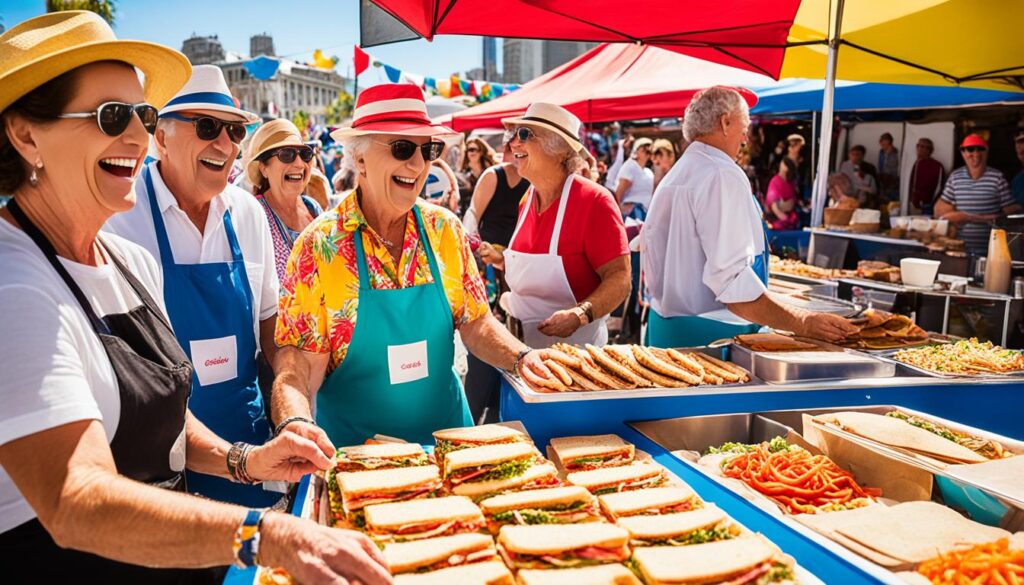Do you know the true origins of the iconic Cuban sandwich? Is it really a Cuban creation or does it have a more complex history? Join us as we delve into the fascinating tale of the Cuban sandwich, tracing its roots and uncovering the cultural influences that have shaped this beloved culinary treasure.
Key Takeaways:
- The Cuban sandwich emerged in the mid-19th century to feed workers in Key West, Ybor City, and Tampa.
- It is a fusion of Cuban and Italian cuisines, with the addition of Genoa-style salami in Tampa.
- The Cuban sandwich has evolved to reflect regional tastes and preferences, with variations like the Miami-style medianoche.
- Key ingredients include sweet ham, savory roast pork, salami, Swiss cheese, pickles, and mustard.
- Creating the perfect Cuban sandwich involves careful construction and pressing to meld the flavors together.
The Evolution of the Cuban Sandwich
Over time, the Cuban sandwich has evolved and adapted to different regional tastes and preferences. In Miami, the Cuban sandwich is typically made with a different type of bread called medianoche, which is softer and sweeter. It also often includes mayonnaise and lettuce, reflecting the influence of other Latin American cuisines. In other parts of the United States, the Cuban sandwich has gained popularity and can be found on menus in various incarnations. Despite these variations, the iconic Cuban sandwich remains a symbol of Cuban culture and a cherished culinary tradition.
In Miami, the medianoche bread adds a unique touch to the Cuban sandwich. Its soft and sweet nature enhances the flavors of the fillings, creating a delightful contrast. The addition of mayonnaise and lettuce brings a refreshing twist and represents the fusion of different culinary influences in Latin America. These variations cater to the preferences of diverse palates and contribute to the ongoing evolution of the Cuban sandwich.
“The Cuban sandwich is a versatile dish that has adapted to different tastes and regions over time. From the medianoche bread in Miami to the diverse ingredients found in other parts of the United States, each variation embraces the culinary culture of its surroundings. Nonetheless, the iconic Cuban sandwich remains true to its roots and continues to be a beloved symbol of Cuban heritage.”
While the Cuban sandwich has taken on new forms and ingredients, it is undeniable that it still embodies the essence of Cuban culture. Whether it’s enjoyed in a traditional Cuban bakery in Miami or at a food truck in New York City, the recognizable flavors and nostalgic connection to the past make the Cuban sandwich a beloved fixture in the culinary landscape.
The Evolution of the Cuban Sandwich: A Regional Comparison
| Region | Bread | Additional Ingredients |
|---|---|---|
| Miami | Medianoche bread | Mayonnaise, lettuce |
| Tampa | Cuban bread | Genoa-style salami |
| Other U.S. regions | Cuban bread, French bread, or Italian bread | Varies, reflecting local influences |
As the table above illustrates, the Cuban sandwich has embraced regional flavors and ingredients. While the traditional Cuban bread is a common thread, different bread types and additional ingredients contribute to the unique variations found across different regions of the United States.
The image above showcases the diverse range of Cuban sandwich creations, with each version paying homage to the traditional sandwich while incorporating regional twists. From the medianoche bread in Miami to the classic Cuban bread with Genoa-style salami in Tampa, the cultural evolution of the Cuban sandwich is evident.
The Ingredients and Flavors of the Cuban Sandwich
The Cuban sandwich is known for its distinctive flavor profile, created by a unique combination of ingredients. Each element contributes to the layers of taste that make this sandwich a culinary delight.
The foundation of the Cuban sandwich is the trio of meats: sweet ham, savory roast pork, and funky salami. These meats work in harmony to provide a range of flavors and textures, from the sweetness of the ham to the savoriness of the roast pork and the boldness of the salami.
Adding to the complexity of flavors is the melted Swiss cheese. Its creamy texture and mild taste complement the meats, creating a harmonious blend that melts in your mouth.
But the Cuban sandwich wouldn’t be complete without the tangy and zesty elements. Pickles and mustard play a crucial role in balancing the richness of the meats and cheese. The pickles provide a refreshing crunch and a sharpness that cuts through the richness, while the mustard adds a tangy kick that enhances the overall flavor profile.
The traditional Cuban sandwich is made with soft white Cuban bread, which is a light and airy loaf containing lard. The bread’s delicate texture and subtle flavor provide the perfect base for the robust fillings. However, variations of the sandwich may use French or Italian bread as alternatives, offering a different taste and texture experience.
To achieve the perfect Cuban sandwich, it is typically toasted or pressed. This technique not only warms the sandwich but also helps meld all the flavors together. The bread becomes crispy on the outside while remaining soft on the inside, creating a delightful texture contrast.
Overall, the ingredients and flavors of the Cuban sandwich work in harmony to create a symphony of taste that has made this dish a beloved culinary tradition.
Preparing the Cuban sandwich involves a delicate balance of flavors and textures. The key ingredients, along with the toasting or pressing process, transform this sandwich into a culinary masterpiece.
Constructing the Perfect Cuban Sandwich
Creating a perfect Cuban sandwich requires attention to detail in its construction. The key is to layer the ingredients in a specific order to ensure the flavors meld together harmoniously.
Start by choosing the right bread for your sandwich. While traditional Cuban bread is ideal, you can also use French or Italian bread as alternatives. Whichever you choose, the bread should have a soft interior and a crisp crust.
To begin the assembly, spread mustard on both halves of the bread. This tangy condiment adds a zesty flavor that complements the other ingredients.
- Place the pickles on top of the mustard. These briny slices give the sandwich a refreshing crunch.
- Next, layer the ham on top of the pickles. The sweetness of the ham balances the saltiness of the other ingredients.
- Add slices of Swiss cheese on top of the ham. The melted cheese binds the fillings together and adds a creamy texture.
- Finally, add the centerpiece of the sandwich – the roast pork. This savory, tender meat is the highlight of a classic Cuban sandwich.
Some variations of the Cuban sandwich may include additional ingredients such as lettuce or mayonnaise. Feel free to experiment and customize the sandwich to your taste.
Once the sandwich is fully assembled, it’s time to give it its signature crispy exterior. You can achieve this by pressing the sandwich using a panini press, griddle, or even a makeshift press with hot surfaces. Pressing the sandwich helps compress the bread and meld all the flavors together.
The Cuban Sandwich in Popular Culture
The cultural significance of the Cuban sandwich extends beyond its culinary appeal. It has become a symbol of Cuban culture and identity, representing the fusion of different influences. The Cuban sandwich has also gained popularity in popular culture and has been featured in various films, TV shows, and books. Its presence in the media has further solidified its status as an iconic and beloved dish.
From food festivals to dedicated Cuban sandwich eateries, this sandwich has captured the hearts and taste buds of people around the world.
“The Cuban sandwich is not just a meal; it’s a cultural icon. Its layers of flavors and textures mirror the diverse heritage and history of Cuba. With each bite, you’re transported to the streets of Havana and the vibrant spirit of its people.” – Chef Maria Rodriguez
In the film “Chef” directed by Jon Favreau, the Cuban sandwich takes center stage as a mouthwatering delicacy that brings people together. Its appearance in the movie showcases the cultural significance and widespread appeal of this culinary masterpiece.
Food festivals dedicated to the Cuban sandwich, such as the annual “Cuban Sandwich Festival” in Tampa, Florida, celebrate its rich history and cultural significance. These events attract participants from all walks of life, highlighting the enduring popularity and universal love for this flavorful creation.

The Cuban Sandwich: A Delicious Journey in Cinema
In addition to “Chef,” the Cuban sandwich has made appearances in other films, demonstrating its presence in popular culture:
- “Chef” (2014) – Directed by Jon Favreau, the film features a mouthwatering depiction of a Cuban sandwich, enticing viewers with its irresistible flavors.
- “The Fate of the Furious” (2017) – In this action-packed film, a character played by Dwayne Johnson is seen enjoying a delicious Cuban sandwich.
The Cuban Sandwich in Literature
The cultural significance of the Cuban sandwich is not limited to the screen. It has also found its way into literature, capturing the imagination of authors and readers alike:
- “Empire of Dreams” by Giannina Braschi – This novel explores the complexities of Cuban culture and identity, with the Cuban sandwich serving as a metaphor for the fusion and diversity found within.
- “The Cubans” by Anthony DePalma – In this captivating book, the Cuban sandwich serves as a culinary symbol of cultural exchange and identity in the United States.
| Film/Book Title | Description |
|---|---|
| “Chef” (2014) | A culinary masterpiece that showcases the mouthwatering allure of the Cuban sandwich. |
| “The Fate of the Furious” (2017) | Includes a scene where a character indulges in the delicious flavors of a Cuban sandwich. |
| “Empire of Dreams” by Giannina Braschi | An exploration of Cuban culture and identity, employing the Cuban sandwich as a metaphor. |
| “The Cubans” by Anthony DePalma | A captivating book that delves into the cultural significance of the Cuban sandwich. |
Conclusion
The Cuban sandwich holds a special place in culinary history and culture, capturing the hearts and taste buds of food enthusiasts worldwide. From its humble beginnings as a simple worker’s meal, it has become an iconic dish that represents the fusion of Cuban and American flavors. The sandwich’s evolution and adaptation over time have allowed it to maintain its traditional essence while accommodating regional preferences.
Whether savored in a traditional Cuban bakery or enjoyed from a trendy food truck, the Cuban sandwich continues to be a beloved classic. Its rich history and cultural significance showcase the power of food to bring people together and preserve traditions. The unique combination of sweet ham, savory roast pork, salty salami, melted Swiss cheese, pickles, and mustard creates a delightful explosion of flavors that has stood the test of time.
As we delve into the world of Cuban cuisine, we uncover not only the delightful taste of this traditional sandwich but also the vibrant culture and heritage behind it. The Cuban sandwich’s enduring popularity and widespread recognition in popular culture highlight its influence and impact on food lovers everywhere. Whether you’re a culinary explorer or a connoisseur of cultural delicacies, the Cuban sandwich promises to satisfy your cravings and introduce you to a taste sensation like no other.
